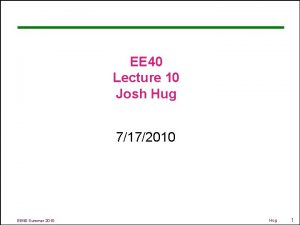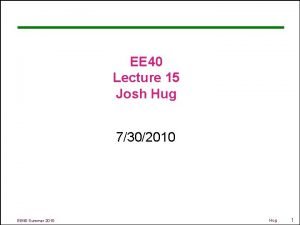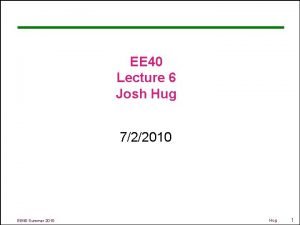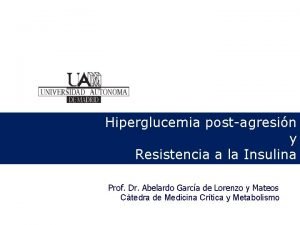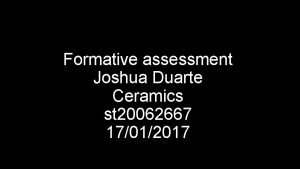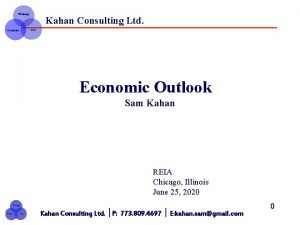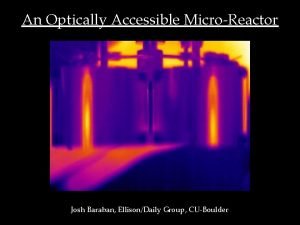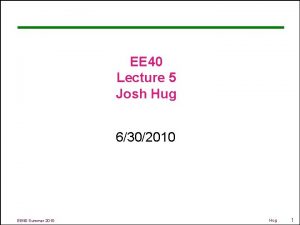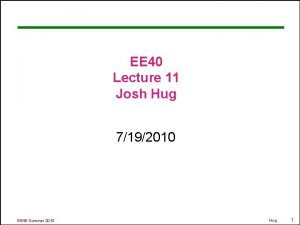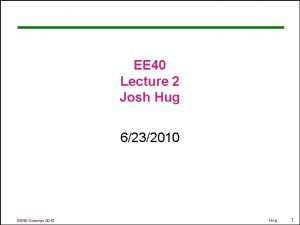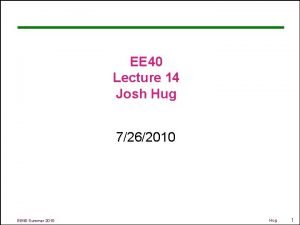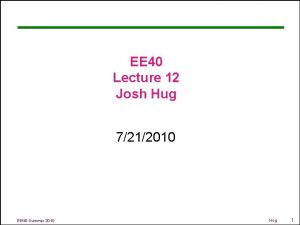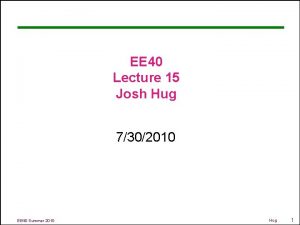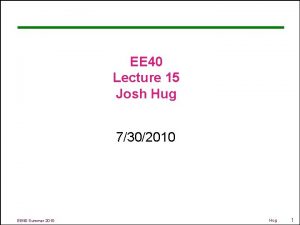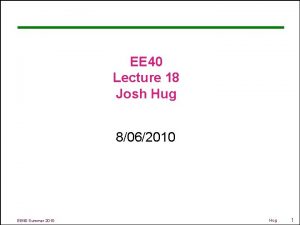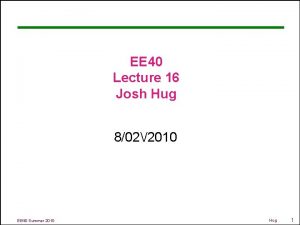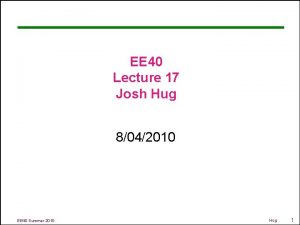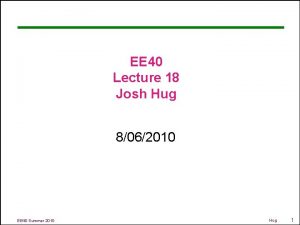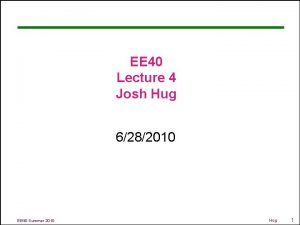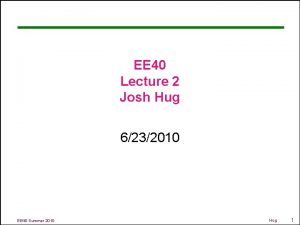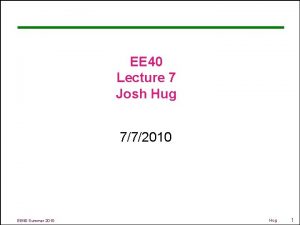EE 40 Lecture 5 Josh Hug 6302010 EE


























- Slides: 26

EE 40 Lecture 5 Josh Hug 6/30/2010 EE 40 Summer 2010 Hug 1

General Info • Lab #2 today • HW 1 grades up on bspace • Make up lab next week – Date TBA • Discussions going back to 2 hours • HW 2 still due Friday at 5 PM – It is long, you should be half done – Get started tonight if you haven’t started yet – Don’t forget about the discussion board – Don’t forget there are other human beings who are also working on this homework EE 40 Summer 2010 Hug 2

The Need for Dependent Sources • Vout Vin EE 40 Summer 2010 RL Hug 3

Operational Amplifiers • Dependent Sources are handy – Allows for decoupling • Only one problem: – They don’t exist • The “Operational Amplifier” approximates an ideal voltage dependent voltage source – Very very cool circuits – Analog IC design is hard EE 40 Summer 2010 Hug 4

Most Obvious Op-Amp Circuit We’ll ignore power supply ports for now e. g. A=1/1000 EE 40 Summer 2010 Hug 5

One Problem • The “open loop gain” A is: – Hard to reliably control during manufacturing – Typically very large (A > 1, 000) – Fixed for a single device • Negative feedback helps us overcome these issues EE 40 Summer 2010 Hug 6

Simple Op-Amp Circuit with Negative Feedback On the board: EE 40 Summer 2010 Hug 7 b

Negative Feedback Op-Amp Circuit Assuming A is very big… EE 40 Summer 2010 Hug 8

Op-Amp Circuit • Output voltage is independent of load! • One op-amp fits all, just tweak your resistors! • Output is independent of A! EE 40 Summer 2010 Hug 9

Wait, so whoa, how did that happen? • and for large A… EE 40 Summer 2010 Where ε represents some tiny number Hug 10 b

The Voodoo of Analog Circuit Design For large A: • EE 40 Summer 2010 Hug 11

The Voodoo of Analog Circuit Design For large A: For this circuit: • EE 40 Summer 2010 Hug 12

Consequence of Negative Feedback • EE 40 Summer 2010 Hug 13

Approach to Op-Amp Circuits • • Our prior approach was to replace the op -amp by dependent source and solve • This opens up a new approach EE 40 Summer 2010 Hug 14

Approach to Op-Amp Circuits • “Summing-point constraint” EE 40 Summer 2010 Hug 15

Negative Feedback Amplifiers • Concept was invented on a ferry to Manhattan by Harold Stephan Black during his morning commute to Bell Labs in Manhattan in 1927, originally sketched out on a blank spot of his New York Times • The idea is bizarre, but really epic – Completely revolutionized electronics – 9 years before patent office believed it EE 40 Summer 2010 Hug 16

If you’re a little lost • EE 40 Summer 2010 Hug 17

Example using the Summing-Point Constraint EE 40 Summer 2010 Hug 18 b

Summing-Point Constraint • You don’t have to use the summing-point constraint • However, it is much faster, albeit less familiar and thus a little tricky at first EE 40 Summer 2010 Hug 19

Op-Amp Circuits • There a bunch of archetypical circuits, the one we’ve studied so far is the “noninverting amplifier” Inverting amplifier Voltage follower EE 40 Summer 2010 Hug 20

Board Problems Time • Let’s go through some problems on the board EE 40 Summer 2010 Hug 21

And then we were done… • We did some op-amp problems in class and then called it a day here, next slides will appear on Friday EE 40 Summer 2010 Hug 22

Op-Amps – How Good Are They Exactly? • Of course, Op-Amps aren’t perfect – You can’t drive every device in the universe from one op-amp • How do we measure how good a voltage source is? – Looking at its Thevenin equivalent – Lower Thevenin resistance is better EE 40 Summer 2010 Hug 23

Measuring the Quality of a Source • RTH + – + VTH EE 40 Summer 2010 RL Vout – So basically, for loads which are more than 99 times the Thevenin resistance, you get >99% of the Thevenin voltage Lower RTH is better, can handle smaller loads 24 Hug

Source Quality Example • Vout Vin 2/3Ω RL a 1/1000 V – + EE 40 Summer 2010 b RL=99*2/3Ω=66Ω load gets 99% of VTH Hug 25

Thevenin Equivalents of Op-Amp circuits • Can look at Thevenin equivalent of an opamp circuit at its output terminals: RTH – + VTH vo • Just like converting a simple resistor based voltage attenuator: 2/3Ω a 1/1000 V – + EE 40 Summer 2010 Hug 26
 Josh hug
Josh hug Josh hug
Josh hug 01:640:244 lecture notes - lecture 15: plat, idah, farad
01:640:244 lecture notes - lecture 15: plat, idah, farad Gimnazija hug
Gimnazija hug Verb groups
Verb groups Proxy fight
Proxy fight Sprawl ap hug
Sprawl ap hug Embiyax su hug
Embiyax su hug Fast hug
Fast hug Define stimulus diffusion
Define stimulus diffusion Pagbati example
Pagbati example The mandt system chapter 1 2 3- relational section answers
The mandt system chapter 1 2 3- relational section answers Primate city rule example
Primate city rule example Simple past smile
Simple past smile Ap human geography remote sensing
Ap human geography remote sensing Maumee watershed district
Maumee watershed district Josh bruns
Josh bruns Josh bostick
Josh bostick Josh reinert
Josh reinert Josh duarte pottery
Josh duarte pottery Josh farley
Josh farley Josh kahan
Josh kahan Josh baraban
Josh baraban Josh davies work ethic
Josh davies work ethic Josh barron medication error
Josh barron medication error Josh christianson
Josh christianson Peacock spider life cycle
Peacock spider life cycle
